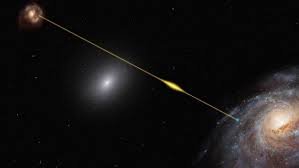Mysterious emissions of radio light from the far reaches of the universe have captivated the attention of modern radio astronomy. These enigmatic phenomena, known as fast radio bursts (FRBs), have become the next big thing in the field, offering a tantalizing glimpse into the cosmic unknown. With their fleeting nature and incredible energy release, FRBs have sparked curiosity and propelled scientific exploration to new heights.
Fast radio bursts are intense flurries of radio waves that travel across vast cosmic distances, originating from distant galaxies. In a mere fraction of a second, an FRB can emit as much energy as the sun produces over the course of several weeks. Despite being the brightest radio bursts discovered in nature, these ethereal signals are incredibly transient, lasting only milliseconds. As a result, capturing and studying them has proven to be a formidable challenge for astrophysicists.
The journey of unraveling the mystery of FRBs began over 15 years ago when the first burst was detected by radio astronomers. Since then, hundreds of these elusive signals have been identified, and the list continues to expand rapidly. As the technology and techniques for detecting and analyzing FRBs improve, our understanding of these cosmic puzzles deepens.
To catch these fleeting cosmic whispers, astronomers rely on large radio telescopes equipped with sophisticated detection systems. These instruments sweep the sky, scanning for radio waves that exhibit the telltale signatures of fast radio bursts. When an FRB is detected, scientists quickly mobilize to record and study its properties. The data collected during these precious moments provide crucial insights into the origins and nature of these enigmatic signals.
Despite the progress made in detecting and characterizing FRBs, their exact origins remain elusive. Several theories have been proposed to explain their nature, including cataclysmic events such as neutron star mergers, magnetar flares, or even advanced extraterrestrial civilizations. Each new burst detected brings astronomers closer to unraveling the truth behind these cosmic enigmas, yet many questions persist.
In recent years, efforts have intensified to localize the sources of FRBs more accurately. By pinpointing the exact locations in the sky from which the bursts originate, astronomers can study the environments and host galaxies associated with these powerful events. This endeavor has led to exciting discoveries, including the identification of repeating FRBs, which emit multiple bursts from the same location. Such observations provide valuable clues and open up new avenues for research.
Beyond the scientific intrigue, the study of FRBs carries profound implications for our understanding of the universe. These bursts serve as cosmic messengers, traversing vast distances and providing insights into the extreme physics and cosmic landscapes that exist far beyond our own galaxy. They offer a unique window into the early universe, enabling scientists to probe the conditions and phenomena that prevailed during its infancy.
As the list of known FRBs grows, the stage is set for future breakthroughs in our quest to comprehend these enigmatic signals. The development of next-generation radio telescopes, such as the Square Kilometer Array (SKA), promises to revolutionize FRB research by providing unprecedented sensitivity and sky coverage. These technological advancements, coupled with innovative data analysis techniques and international collaborations, hold the potential to unravel the mysteries of FRBs and shed light on the hidden corners of the cosmos.
In the realm of modern radio astronomy, fast radio bursts have emerged as a captivating frontier. Their fleeting nature, immense energy release, and elusive origins have sparked a scientific fervor that continues to drive exploration and discovery. With every new burst detected, we edge closer to unraveling the secrets that lie within these cosmic enigmas, and with them, a deeper understanding of the vast universe that surrounds us.


